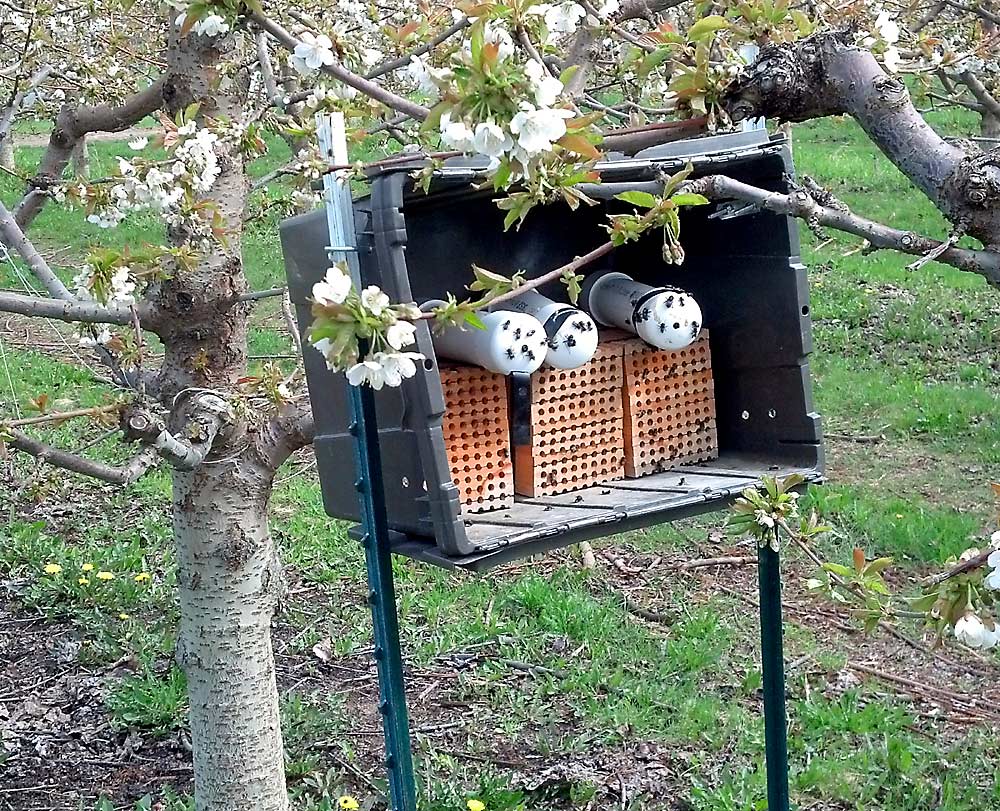
Research has shown that teaming mason bees with honey bees can improve tree fruit pollination, but a shortage of the solitary pollinators and the labor-intensive management they require have been stumbling blocks to commercialization.
That changes this year, said Jim Watts, owner of Watts Solitary Bees of Bothell, Washington. Watts now has enough insects to begin serving Northwest tree fruit growers and a machine to dramatically speed nest cleaning, one of the time-consuming chores in mason bee care.
“We’re in the place where we now have bees,” said Watts, the largest native bee supplier in North America.
Watts has been reaching out to tree fruit growers to train them how to place and care for mason bees. Watts has trained some blueberry growers in Oregon’s Willamette Valley and British Columbia, as well as a few tree fruit growers in Oregon and Washington.
“The issue that we have is that (California) almonds have been taking all our bees every year,” he said, leaving few for tree fruit growers. This year, however, Watts has about 1 million bees — enough to pollinate roughly 1,000 acres of tree fruit.
Unlike imported honey bees that live in colonies, mason bees are native to North America and live solitary lives. They work blossoms in cooler weather than do honey bees, fly different patterns among the rows, forage on different parts of the flower and carry pollen differently. Plus, they produce only one brood a year to overwinter in cocoons that orchardists can store and place again the following spring.
In Washington trials, blue orchard bees (a species of mason bee) paired with honey bees improved fruit set in sweet cherries from 50percent to 70 percent in 2019 over honey bees alone, and from 37 percent to 63 percent in 2020, said Lindsie McCabe, an entomologist at the U.S. Department of Agriculture’s Pollinating Insect-Biology, Management, Systematics Research Unit in Logan, Utah. The third year of trials will continue this year.
However, the mason bees caused no significant difference in yield in the USDA trials, as reported by growers. Similar things have happened in almonds. Researchers are not sure why, said Theresa Pitts-Singer, also an entomologist at the Logan laboratory.
Jim and Sandee Freese, tree fruit growers in Omak, Washington, believe mason bees have consistently doubled yields in their 4-acre Staccato cherry orchard since they began using them in 2015. That year, facing a cool pollination window, they heard Watts speak at a local horticulture meeting.
“I decided it was worth a shot,” Jim Freese said.
Their 9 acres of organic Bartlett pears seem bigger in fruit size since then, too, but they’ve really noticed the difference in cherries.
The couple still rents somewhere between one and two honey bee hives per acre and lets the two species work in tandem.
“They seem to make each other work more, kind of like competition,” Sandee Freese said.
Question of scale
Supply has been one hurdle for mason bee adoption; time is another.
Growers must build shelters, place cocoons, clean nests, wash cocoons and store everything until the following year.
For Jim Freese, much of that happens when he’s not busy with other chores. The part that trips him up is keeping moist clay around for the bees to use for nesting during the spring. He digs clay from a vein elsewhere on his property and places it in 5-gallon buckets cut in half and leaned against trees. Each day, he adds water to the bottom of those tubs for the clay to wick up. “At a busy time of year like that, I haven’t been as good at that as I should be,” he said.
As a result, he hasn’t recaptured many bees and plans to purchase 12,000 pupae from Watts this year, at 40 cents each.
Labor concerns prevented Mike Omeg, a cherry grower in The Dalles, Oregon, from investing in mason bees at a commercial level. He likes the idea and tried it about 10 years ago. He also has kept in touch with other growers who swear by mason bees and is participating in research with Oregon State University to find ways for growers to encourage native bees to visit orchard trees.
Still, he doesn’t see mason bees scaling. They take too much work for a 3,500-acre farm.
“Lots of things have potential, but not everything can scale,” Omeg said.
Watts believes mason bees can scale, once growers get the hang of the routine.
The bees are rentable, but Watts recommends a business model in which growers purchase bees and, as part of the package, let him consult. That will give growers more incentive to take care of the bees and recapture more for the next year, bringing down their prices over time.
Growers recapture the bees in laminate boxes with tubes in which the bees pack mud for their nests. Female bees live only about four to six weeks and die after they lay eggs.
Also, Watts’ company has developed a machine that automates nest cleaning, he said, and he plans to commercialize that over the next few years. When it comes to washing cocoons, he uses a simple bleach solution and plastic tub, cleaning 150,000 of them in an hour.
Brian Bly, a California almond grower near Sacramento, has about 350 acres under joint honey bee and mason bee pollination and plans to increase to 1,000 acres by 2022, he said. Once the infrastructure is in place, Bly estimates spending about $20 per acre per year in labor caring for the bees.
The initial price can be a hurdle, too, he admitted. He pays 30 cents for each bee, and it costs about $80 per acre in material to set up nesting shelters. But a lot of the mason bees return at the end of season. Assuming a 40 percent return rate, the overall cost of the two-species model evens out with that of honey bees alone after about five years, he said.
Done right, the mason bees can work on a commercial scale, he said, and he and Watts come closer to proving that each year.
“We’re getting there,” Bly said. •
—by Ross Courtney

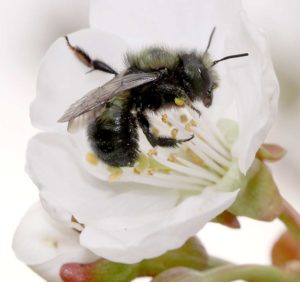
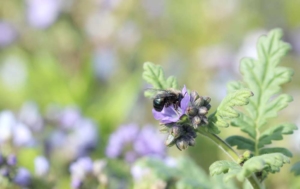
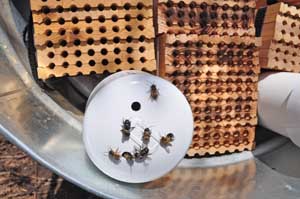
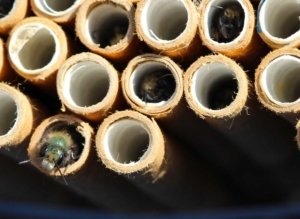





Leave A Comment